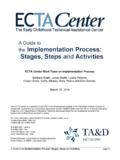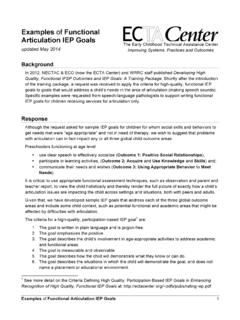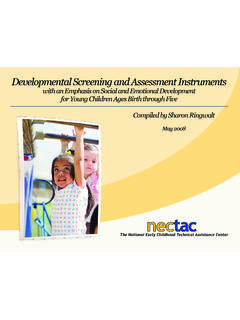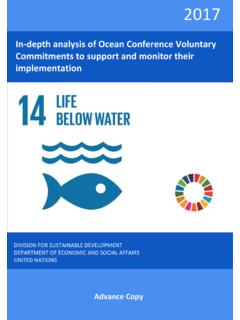Transcription of Implementing and Sustaining an Effective Service …
1 The National Early Childhood Technical Assistance Center919-962-2001 phone 919-966-7463 web emailImplementing and Sustainingan Effective Service Delivery Approach:Stages and StepsImplementing and Sustainingan Effective Service Delivery Approach:Stages and Steps December 2011 This document has been excerpted from the NECTAC Interactive Guide to Implementing and Sustaining an Effective Service Delivery Approach: Stages and Steps (2011). For the full version, which includes greater detail and downloadable resource documents, visit: This guide describes five major stages in the process of changing your state's Service delivery approach and the critical considerations and steps that need to be addressed for each stage.
2 While not a rigid sequence of activities, there is a logical flow. In actual implementation, the activities may cross stages and may be worked on simultaneously. Also, a change effort may begin at a later stage but back-track to do the work of the earlier stages. Introduction Over the last 10 years, states' lead agencies for Part C Infant and Toddler early intervention programs began to seriously examine their approach to Service delivery for infants and toddlers with disabilities and their families. Evidence from research, model demonstration and outreach projects has produced national awareness of validated practices in early intervention. There is a growing consensus about Effective practices and the mission and principles of early intervention that are relevant across specific models, providing a "model neutral" view (see Key Principles and Practices for Providing Early Intervention services in Natural Environments).
3 In addition to the growing evidence-base, increasing pressure from federal monitoring, growing numbers of children served, and difficulties of recruiting and retaining various disciplines to work in early intervention also motivated states to closely examine how the Service system was structured, and the nature and timeliness of Service delivery. State administrators began to explore the various team-based approaches to find a way to provide more efficient and Effective services and to extend the reach of scarce personnel. By 2011, 34 states were engaged in work to explore or change their Service delivery approach. The stages and considerations were developed by analyzing 3 states' long term system change plans; reviewing the implementation literature and incorporating extensive feedback from NECTAC and NIRN staff with experience in Implementing long term systems change.
4 Resources were collected from a survey of state Part C Coordinators who are involved in this work, web searches and literature reviews. The stages suggest a sequence of activities, but in actual implementation, some stages may be worked on simultaneously. Also, a change effort may begin at a later stage and then back track to do the work of earlier Explore Service Delivery Approaches with Stakeholders There are many nationally known models, evidence-based components and practices and trainers who can support adaptation or adoption of various approaches. A state, regional or local program must consider how any approach "fits" with their infrastructure, management and staffing. Most important, all stakeholders should be included in exploring approaches, and determining the "fit" with their values and their vision of the mission and principles of early intervention.
5 An articulation of the critical components of the approach, including practices, processes and procedures is vital to guide implementation. Step: Articulate Mission Identify and bring together a diverse group of stakeholders that will develop a common understanding of the scope, mission and principles for the Part C Program. Identify and bring together a diverse group of stakeholders that will develop a common understanding of the scope, mission and principles for the Part C Program Define the scope and purpose of Part C services provided under their Infant Toddler Program Develop or reaffirm mission and principles that will underlie the Service delivery approach Step: Compare Approaches Explore Service delivery approaches or models to select the core features and components of Service delivery that the state wants to adopt/adapt.
6 Review literature, gather information from other states and consultants Identify desired core features and functions of each approach; discuss benefits, implementation process and potential fiscal impact Choose the approach that best aligns with mission, values and desired direction for the state Step: State Desired Changes Compare the current Service delivery system and practices to the desired approach and articulate the desired outcomes / changes needed. List the concerns /problems the state is trying to address, at all levels of the Service system ( , state, regional, local services children and families) List desired outcomes/changes for all levels that the new approach will address Review infrastructure & current Service delivery, including issues, concerns, strengths; what to keep and what to change Step: Explore Implementation Begin discussion about how to implement, evaluate and sustain new approach.
7 Explore/measure readiness of potential adopters, commitment of leadership (Begin to plan the evaluation questions and methods) Study implementation and sustainability literature Implementing and Sustaining an Effective Service Delivery Approach: Stages and Steps22. Build Support and Commitment Successful implementation of any Service delivery approach is dependent on widespread support among a diverse stakeholder group. Change requires champions, advocates and committed leadership. Stakeholders likely to be resistant should also be included and their input used to address concerns and garner more persuasive information. Building multiple communication channels with the field and using those channels to get information out and reactions and feedback to the implementers is vital.
8 Implementers need to build public support through sharing the vision of infant and toddler services and the research and information that supports it. Step: Advocate for Changes Provide multiple opportunities to raise stakeholder group's awareness, understanding and commitment so that they can advocate with their constituencies to support the selected Service delivery approach. Make sure stakeholders understand the research and evidence base supporting Service approach Provide multiple opportunities to raise stakeholders' awareness, to get questions asked and answered, to clarify what supports or changes are needed to successfully implement Use stakeholder input to tweak the Service delivery approach and/or consider in the implementation plan Step: Secure Leadership Support Identify administrators and decision makers whose buy in will be needed to assure necessary support and resources for implementation and sustainability.
9 Identify within the lead agency and supportive agencies (Medicaid, state insurance, collaborators) who will need to be supportive of the changes Use multiple relationship-building methods and communication strategies to turn them into champions who will help promote the Service delivery approach Step: Develop Communication Plan Develop communication plan to build statewide understanding and buy in. Identify a variety of audiences , messages, materials, and formats appropriate to each Identify potential opposition, their issues and your response Develop multiple communication strategies assure you disseminate information out to stakeholders and get feedback from them Make sure your plan includes ways to use your stakeholders and champions to promote the Service delivery approach Step: Develop Messages/Materials Develop, evaluate and refine "PR" materials/activities for your identified audiences.
10 Broadly disseminate the Purpose of Part C, Mission and Principles statements Develop common language, benefits for all stakeholders (outcomes at all levels) Describe core features/ components of the new approach to Service delivery Include evidence supporting the new approach Implementing and Sustaining an Effective Service Delivery Approach: Stages and Steps33. Develop Implementation Plan A long term implementation plan creates a path to achieving desired outcomes of adopting the selected approach. Activities at each level of the Service system are necessary to assure desired practices are supported and maintained, including infrastructure changes at state and regional/district and local levels, and T & TA capacity necessary to provide and sustain needed training.
















